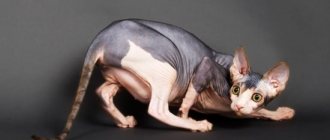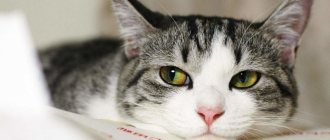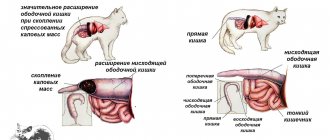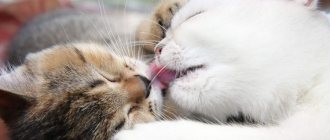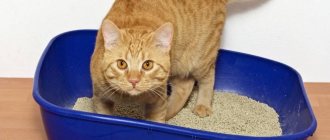A pregnant cat needs special care. Problems arise both during childbirth and during gestation itself. A loving owner needs to know how long his cat will be pregnant in order to prepare for the big day. The usual period is 60-72 days. If the kittens appear before this time, they will be weakened or die. And if gestation, on the contrary, lasts longer, then there is a risk of death of the mother herself.
The due date is easy to calculate if the mating was planned in advance. Conception occurs 1-1.5 days after mating. However, there are discrepancies of two to three days.
When is a cat ready to become a mother?
Puberty in felines occurs in 4-5 months, and can last up to almost a year - this is influenced by many factors. The female can become pregnant at the age of 5-9 months. If she is walking on her own or there are several animals in the house, it is better to think about this in advance. Mating is considered optimal at one and a half years, when the body is fully formed and ready for pregnancy and the birth of kittens.
A lot also depends on the time of year. As a rule, sexual heat in street animals (they go to the toilet outside, go for walks) begins in January and continues until November. The peak occurs in the warm season. Pets are ready to breed all year round.
Most often, cats become pregnant in the summer, but in general it can happen at any time of the year.
Puberty of cats
The onset of puberty depends on belonging to a particular breed. For example, Siamese and Balinese ripen earlier. Representatives of large-bodied breeds, Maine Coon and Scottish Straight, are distinguished by late maturation. Physiological maturity also depends on the time of birth of the kitten. Those born in summer become sexually mature faster than in winter.
During the maturation period, the so-called “cat” songs begin. These are gentle meows and uterine sounds that communicate intentions. Such “concerts” can last a long time . The cats become overly affectionate and loving. They constantly clean themselves up and mark their territory. They often rub against the owner's legs and the legs of tables and chairs. A caring owner understands that it is time for the pet to look for a partner. But when your cat is in heat for the first time, you should not pair her with a male cat. Puberty does not yet indicate the complete physical development of an animal.
The body's readiness to bear healthy kittens occurs at fourteen months.
It happens that a cat demands a cat, but due to her age she is not yet ready for pregnancy. In this case, on the advice of a veterinarian, you can reduce libido with medications. This will calm your pet, and she will stop asking to go outside. The owner will protect himself from unplanned mating and the associated unwanted pregnancy of the cat. During courtship, cats receive multiple wounds in fights with rivals. After running away from home, pets can return infected with various diseases, including parasites. Therefore, during the period of heat, owners should carefully monitor their pets.
Signs of pregnancy in a pet
Noticing that your cat will soon become a mother is not always easy - animals will not tell us about their well-being. However, we can carefully observe our four-legged friend and identify changes. First of all, you need to understand whether the female and male had sexual intercourse. It only lasts a couple of seconds. This can be recognized by the cat’s behavior: it will move away from the cat or even show aggression, and also lick the genital area. Now we can talk about the signs of a cat’s pregnancy:
- The heat stops. A female can become pregnant not at any time, but only during estrus. It happens several times a year, which is accompanied by special symptoms. For example, a family favorite becomes too affectionate, rolls on the floor or rubs against the owner’s legs, and meows invitingly loudly. After conception, all this comes to naught: the pet seems to become indifferent, and the cat begins to irritate the cat. She hisses at him and doesn’t let him near her, since she’s no longer interested in mating.
- Behavior. At the beginning of pregnancy, the female often changes: she refuses food, shows excessive affection or aggression, looks lethargic, and may go to the toilet frequently. This is usually a short-term phenomenon and goes away in a few days. It's no wonder that many owners don't even have time to notice.
- The mammary glands change. The cat's nipples become brighter in color and swell by the third week. At this moment, the fur around them seems to move apart, exposing them.
Pregnant cats' nipples become more noticeable.
How to determine that your pet has been pregnant for a long time? Gradually, her weight will begin to increase, but for some it changes slightly. Almost all females become calmer, refuse active games, and prefer to sleep more. In the later stages, they often begin to search for a secluded place for childbirth.
Important! You should not try to palpate the fetus, as this can cause serious harm to the animal.
A visit to the veterinarian and a diagnosis is the most reliable way to know that your cat will soon have adorable kittens. At the clinic, the doctor will suggest doing an ultrasound or conducting a blood test to determine the level of the hormone relaxin.
Ultrasound diagnostics is the most reliable way to find out a cat’s gestational age and the number of fetuses.
False pregnancy
It also happens that a cat ovulates, but conception fails. Sometimes this ends in a false pregnancy. The hormonal background changes as if the female is expecting offspring, but in reality there is none. This phenomenon can lead to changes in behavior, so consultation with a specialist is necessary in some cases.
How to tell if your cat is pregnant
It is extremely desirable for a cat owner to know that his pet has become pregnant. It is important to establish the moment of mating, because it is from this point that the countdown of a cat’s pregnancy begins. This is not difficult for owners who themselves determine the “wedding day,” but those whose kitties have arbitrarily decided to have offspring, left unattended, are often caught by surprise.
Ultrasound for a cat
The fact of early pregnancy of a cat can only be accurately confirmed by an ultrasound examination of its abdominal cavity. Already in the second week from the moment of conception, ultrasound equipment recognizes the amniotic sac, and in the third week it records the fetal heartbeat. Experienced veterinarians are also able to detect early pregnancy by palpation.
If you think your cat might become pregnant, keep an eye on her. The first suspicious signs appear around the tenth day after mating. You will notice that the kitty has become extremely affectionate and more demanding of your attention. Much less often, but it happens that the animal, on the contrary, tries to retire and avoids touching. The pet becomes drowsy, slow, in a word, its behavior changes noticeably.
The first signs of pregnancy also appear in changes in the taste preferences of the expectant mother. She may become interested in foods that she previously did not like. The animal's appetite is also an important indicator. At first it may decrease, morning sickness is possible, but then the cat begins to demand larger and larger portions of food.
Noticing that the cat's mammary glands have swollen and darkened nipples will confirm your suspicions. Such signs appear in the third week of pregnancy. There will be no doubt at all when, by the end of the fourth week, the cat’s tummy begins to noticeably round, then increasing day by day.
How long does pregnancy last
The answer to the main question, how long pregnancy lasts, is from 57 to 66 days from the moment of successful mating. It is not enough just to know the duration of an interesting situation. The owner needs to understand how each period goes and what to expect from the pet.
So, pregnancy in felines lasts approximately 2 months. It is difficult to set an exact deadline, since it depends on several things. Firstly, it is not always possible to find out exactly when the female and male had a successful mating. Secondly, the duration of pregnancy is influenced by the number of kittens in the litter. Thirdly, the cat breed plays a big role:
- Siamese - 66-68 days;
- oriental - 66 days;
- British - 63-64 days;
- korat - 62-63 days.
These are average values, but still worth taking into account. Especially when it comes to premature birth and the pet needs the help of a specialist.
About two months pass from conception to the birth of kittens.
Early labor
Felines also experience premature birth - this is the birth of kittens before the 57-60th day. It is necessary to immediately seek the help of a veterinarian, because premature birth threatens the lives of babies (they may not yet be able to suck milk or breathe on their own). It is better to call a veterinarian at home as soon as the female begins to give birth.
Labor can begin earlier even in multiple pregnancies. This often happens when a cat is carrying up to 5-7 kittens. Childbirth not quite on time (literally a few days earlier than expected, for example, 55-56) in this case is considered the norm.
Unfortunately, the death of a fetus in the womb is not uncommon - then the female gives birth to only one kitten (the dead one), and will continue to carry the rest according to their due date. However, partial labor is a reason to take your pet to the vet immediately. He must make sure that the rest of the babies and the expectant mother are not in danger.
Post-term pregnancy
Sometimes, when labor does not begin for a long time, owners are interested in something completely different: how long can you walk in position? Do not worry until 70-73 days - only from this period the pregnancy is considered post-term. It is not at all a fact that you have correctly determined the date of conception. It is also necessary to visit a specialist: x-rays and ultrasound will help you understand how soon the babies will be born. Diagnostics will allow you to determine the weight and size of the fetus as accurately as possible, and then, based on this, draw a conclusion about the cat’s gestational age.
Post-term pregnancy is not uncommon for cats. However, not every owner knows the exact date of conception.
Description by week
Why do you need to know how a cat’s pregnancy progresses week by week? Sometimes even minor changes in her condition indicate serious problems and require a visit to a specialist.
Fertilization occurs a day after sexual intercourse, but for this it is necessary that the eggs enter the fallopian tube (ovulation). In cats, ovulation occurs during the mating process. Having multiple sexual intercourse over a short period of time will increase the chance of pregnancy. For fertile caudates, one mating is enough.
At 1–3 weeks, the fetus is attached to the walls of the uterus, then the formation of the most important systems of the body begins. In the first weeks, the placenta forms. The size of the fruit is no more than 1 cm.
At 4–6 weeks you can already find out the exact number of embryos using ultrasound. The size of the offspring reaches 4–6 cm. At this time, they already have barely noticeable fur. As mentioned earlier, it is not advisable to palpate kittens. In addition, the uterus fills with fluid, and only a specialist can cope with this task. By the age of 4–5 weeks, tailed cats recover slightly, especially if they are carrying only two or three kittens.
Babies continue to grow actively - by 7–9 weeks their body length reaches 8 cm, and their weight reaches 100 g. Gradually they become more active, so movements can often be seen by wave-like fluctuations in the cat’s abdomen. At the end of pregnancy, the mammary glands of the expectant mother swell even more, and minor discharge is possible from the genital tract.
Cat gestation period
The minimum period allotted by nature for a cat to become pregnant is 55 days, the maximum is 72 days.
According to the observations of owners, the average gestation time for a cat baby is 60-68 days. The gestation period of animals of different breeds varies, although slightly. Long-haired cats bear their offspring slightly longer than short-haired cats. For example, furry beauties from the Maine Coon breed have to wait 66-68 days for a happy moment, and representatives of the Siamese-Oriental group – only 59-64 days. Felinologists have determined the average duration of pregnancy for cats of different breeds. So, for example, it amounts to
- British Shorthair – 63-69 days,
- Scottish fold – 62-69 days,
- Bengal – 61-70 days,
- sphinx – 63-66 days,
- Somali and Abyssinian – 63-65 days,
- Persian - 63-66 days.
In cats bearing 1-2 cubs, the gestation period often reaches 72 days, and future mothers with many children can expect the appearance of offspring as early as 58 days.
The duration of gestation of kittens is often influenced by stressful situations for pregnant animals - moving, renovation, guests staying for a long time, noisy events. In such cases, childbirth may occur earlier or later than the moment established by nature.
Caring for a future mother cat
If in dogs the nutritional needs during pregnancy change only by the second month, then in cats it changes immediately. They need more calories, nutrients, vitamins. Having noticed the first signs, it is advisable to increase the portion. The specific food is high in calories and contains a sufficient amount of fatty acids due to Omega-3 (they are required for the normal development of embryos). Biologically appropriate food SUPERPET is ideal for pregnant and lactating cats. During this period, you need to increase the daily norm by 100%.
Still, with a pregnant female you need to visit a specialist at least once. You should tell him about your diet, as well as the medications you give to your pet (for example, against parasites). Some of them lead to fetal malformations. Vaccination during this period is not the best idea, so vaccinations should be considered in advance.
While carrying kittens, the female should be calm and not stressed. If there are children in the house, you need to explain to them why you can’t cuddle your pet or play active games with her. Caring for a pregnant cat should not be too intrusive - the animal must be handled with extreme caution. Exhibitions, travel, and flights will clearly not benefit the tailed one.
You can’t squeeze a cat in a position; a miscarriage may occur.
Initial signs
It is difficult to find out if a cat is pregnant at first.
Symptoms that indicate that she is expecting offspring appear after 3-4 weeks:
- behavior becomes calm. The cat sleeps constantly;
- some feel weak, and occasionally you may notice that the animal is vomiting;
- appetite and food preferences change;
- becomes aggressive towards the opposite sex: hisses and arches his back;
- after 20 days the nipples turn pink;
- at four weeks, when stroking the cat, you can notice the cubs moving;
- at 5-6 weeks the belly becomes large;
- a cat's weight increases 1.5 times during pregnancy;
- 10-14 days before birth, the search for a place to build a nest begins.
At the veterinary clinic, ultrasounds are performed to determine how long the cat will bear kittens. The study is carried out two weeks after mating.
After 10 days, its presence can be determined by palpation. This procedure is carried out within a matter of days. Then it will be difficult to palpate the cubs due to the large amount of amniotic fluid in the uterus.
Childbirth is coming soon: signs and course
It is extremely important to know what precedes an early birth. This information will allow you to better understand the expectant mother and have time to prepare for the birth of babies. She may need first aid during this difficult process.
Signs
A harbinger of labor in a cat is considered to be an extremely calm state a couple of days before the onset. There is also a sharp decrease in appetite and a search for a secluded place. As a rule, it is difficult for the expectant mother to walk; most of the time she prefers to lie down. Perhaps he will fawn over the owner and follow on his heels, hinting at your help. The most striking signs can be seen 3–5 days before lambing.
You can reduce your pet's anxiety by creating a cozy nest for the birth of babies during pregnancy. Usually they use a large box or a ready-made house. It is important to cover it with a clean cloth and place it where there are no people. A cat always looks for a distant place to give birth so that no one will disturb her.
Animals during pregnancy may have different opinions on this matter - some choose a closet for lambing or hide under the bed. Ideally, you need to give the expectant mother a room where she will feel comfortable and safe. The constructed house should be prepared several weeks in advance so that the tailed animal has time to get used to it.
A cat needs a secluded area to give birth to kittens.
Course of labor
Having noticed the precursors of childbirth, it is recommended to examine the animal. The cat begins to have mucous discharge from the genital tract, which will facilitate the process. She will begin to actively lick the area under the tail - you will definitely not miss the beginning of birth. It is worth preparing for it in advance to help your pet survive the appearance of offspring. What you may need:
- surgical gloves (several pairs);
- clean scissors;
- dry cloth;
- small syringe;
- antiseptic (iodine, brilliant green, etc.).
It will be better if a specialist monitors the birth process. However, you can cope on your own, the most important thing is not to panic. Even during pregnancy, find a doctor who can advise you over the phone if necessary.
The first signs of labor are contractions. They can last up to 12 hours and are accompanied by bleeding. The expectant mother behaves restlessly: she rushes around the house, screams, and tries to stay closer to the person. You can gently massage the abdomen and speak in a gentle voice.
Kittens pass through the birth bladder head first. Next, the female must bite through the amniotic sac, gnaw the umbilical cord and lick the crumbs. Sometimes the owner has to help: cut the umbilical cord himself with clean scissors, clear the mouth and nose of mucus. It doesn't hurt to first make sure that the cat doesn't mind your help.
A cat can give birth on its own, but with the help of the owner and the veterinarian, the process will definitely be safe for her and the kittens.
The duration of labor usually does not exceed 7–8 hours (from the moment the abdominal cramps begin until the kitten is born), but the process sometimes drags on for up to a day. The fewer kids, the faster everything goes. If the expectant mother has no pathologies and the pregnancy is proceeding normally, everything will be easy. Still, be careful and, if necessary, immediately seek help from a veterinarian.
After birth, the mother quickly returns to normal, although spotting can last up to three weeks. In the absence of alarming symptoms (nausea and vomiting, weakness, fever), this is not a pathology.
In conclusion, let us recall that gestation in cats lasts on average 2 months (57–60 days). Some breeds have different gestation periods. Even during mating, it is worth observing the behavior of your pet in order to determine the date of conception as accurately as possible. It will not be superfluous to prepare in advance for the birth of furry babies by building the correct diet for the cat using the species-typical SUPERPET nutrition.
How long does it take for a cat to go into labor?
When the expectant mother's water breaks, the owners have a question: in how many hours will the due date arrive? After this period, the time for complete dilation of the uterus begins. About 20 minutes later, the cat gives birth and the first child appears. But it’s impossible to say how long it will take for the second kitten to appear, because it depends on the physiology of the pet. Sometimes kittens appear one after another, and sometimes with an interval of several hours; most often, the difference between the first kitten and the last can be 4 hours.
Possible problems
During pregnancy, a cat may experience health problems caused by genetic disorders, infectious diseases or external causes. In this case, the life and health of the pet depends on how quickly the owner contacts the veterinarian.
Premature birth
If labor begins earlier than 56 days after mating, it is considered premature. Premature kittens aged 50–55 days can still be released, but with those born even earlier there is very little chance of success.
If your cat goes into premature labor, you need to take her to a veterinary clinic as quickly as possible.
The main causes of premature birth are:
- developmental disorders in kittens;
- infectious diseases (mycoplasmosis and others);
- injuries and falls;
- severe stress;
- problems with the placenta.
Signs of the onset of premature labor:
- cat anxiety;
- vaginal discharge;
- heat;
- contractions.
It is necessary to take the cat to the doctor as quickly as possible, because he may have time to relieve the tone of the uterus with the help of special medications and give the pet a chance to bear kittens. If it is already too late, then the doctor has more opportunities to ensure the animal a successful outcome of premature birth.
Post-term pregnancy
If the kittens are not born before day 70, the pregnancy is considered post-term. Sometimes cubs born on days 70–75 turned out to be quite healthy, but this is rather an exception to the rule. Most often, failure to give birth on time means that the kittens died in the uterus from hypoxia. Then, to save the cat, the doctor performs a caesarean section or removes the entire uterus. The causes of post-term pregnancy can be:
- a large number of fruits;
- fruits are too large;
- body features of the animal (narrow pelvis);
- hormonal disorders.
Most often, the problem of post-term pregnancy is solved by caesarean section in a veterinary clinic.
Uterine bleeding or miscarriage
Sometimes after an injury, a cat will begin to bleed from the vagina. It is the cause or sign of an incipient miscarriage. It is important to consult a doctor as soon as possible, then the pregnancy may be able to be saved. Miscarriage is often caused by uterine torsion. This is the name for bending or twisting of the long horns of an organ that occurs due to injury. This leads to intrauterine death of kittens and removal of the uterus.
In case of miscarriage and uterine bleeding, only a veterinarian can help
In addition to uterine torsion, the causes of miscarriage may be:
- family ties between parents;
- breed characteristics;
- age of the cat;
- parasite infection;
- poisoning;
- obesity.
Signs of miscarriage:
- any vaginal discharge (except clear white in late pregnancy or bloody a day or two before birth), especially if it has an unpleasant odor;
- fever;
- weight loss and appetite;
- vomit;
- weakness;
- abdominal asymmetry;
- anxious cat behavior.
Ectopic pregnancy
A pathology in which the fetus develops outside the uterus is called an ectopic pregnancy. It can be primary (the fetus is attached outside the uterus from the very beginning) and secondary (the fetus leaves the uterus as a result of its rupture due to injury or pathology of the reproductive organs). In both cases, normal development of the embryo is impossible, it is doomed to death, and if it is not removed in a timely manner, the cat will also die. After all, as a result of an ectopic pregnancy, she develops sepsis, tissue necrosis or damage to internal organs. The most favorable outcome is when the embryo is removed from the cat’s body on its own, in the form of a miscarriage.
If any signs of pathological development of pregnancy appear, you should immediately contact a specialist.
An ectopic pregnancy is life-threatening for a cat; in such a situation, it is necessary to remove the embryo from the abdominal cavity as quickly as possible
Parallel pregnancy (superfecundation and superfetation)
In cats, there is such an interesting phenomenon as parallel pregnancy.
Superfecundation is the simultaneous fertilization of a cat's eggs with sperm from different cats. This happens when a cat mates with several males during one ovulation period. As a result, the eggs receive different genetic material, and the kittens of the same litter may be completely different and have different fathers. In principle, this option is not dangerous for the cat and is no different from standard pregnancy.
When a cat has superfecundation, in one litter there are kittens from different fathers that are completely different from each other
Superfetation is the simultaneous gestation of two litters of kittens at different stages of maturation. This can happen if an already pregnant female copulates with a male again (usually at 3 weeks from mating), resulting in a second, younger litter of cubs appearing in the womb. Thus, the two groups of kittens develop several weeks apart. This situation rarely ends well. Often during the birth of an early litter, the later one dies, as the uterus pushes out the premature younger kittens. It happens less often that the early litter is successfully born, while the later one remains in the uterus and develops normally there for several more weeks, after which a second birth follows.
In case of superfetation, you need to take the cat to the veterinary clinic for birth, this will increase the chances of survival of kittens of the younger litter
With superfetation, problems may arise due to the mother's insufficient teats for all kittens or insufficient milk supply. But these difficulties can be solved by the cat owner by taking upon himself the responsibility of feeding some of the babies.
Sometimes an owner has to literally feed his pet's kittens
How to care for a pregnant cat?
The future cat mother does not require special care. You need to pay more attention to her diet. There is no need to overfeed your cat, but its diet should be balanced. You can include more milk and meat in the menu. If she eats dry food, it should have a high content of vitamins and beneficial microelements.
How is pregnancy progressing?
A cat, unlike other animals, becomes pregnant directly during sexual intercourse. Sperm combine with eggs to form zygotes - fertilized eggs. This happens immediately after mating or no later than 24 hours.
Pregnancy in cats can be divided into 3 stages.
First stage
The fertilized egg begins to divide in the fallopian tube, which takes approximately 10-11 days. The embryos then descend into the uterus. For another 2-4 days they move around the uterus, and by 12-14 days they are attached to its walls. The placenta begins to form - it is a kind of conductor of oxygen, nitrogen and other compounds from the blood. Then the rudiments of the gastrointestinal tract, circulatory system, and nervous system are formed. By 19-21 days, internal organs are formed, the front and hind legs, the brain are formed, the auditory canals appear, the eyes acquire pigment.
The first three weeks are the most important period of pregnancy. Any use of medications or other effects at this time can negatively affect the formation of the fetus and cause deformities.
At the first stage, the first signs of pregnancy begin to appear - the nipples become larger and pinker than usual. An experienced veterinarian, despite the fact that embryos are the size of peanuts (1-2.4 cm), can feel and even count the number of “peas”.
Second phase
From day 21, development accelerates significantly:
- On days 21-23 the size of the embryo is 1.3-3 cm, and from days 23 to 25 it is 1.7-3.4 cm.
- Days 25-28 - dimensions 2.1-4 cm. By day 28, the embryo is already completely similar to a small kitten, so the term “fetus” begins to be used.
- 28-32 days - fetal length 2.5-5 cm. Internal organs take their final places, ears appear, cartilage gradually begins to ossify. At this stage, it is difficult to determine how many fetuses the cat has.
- 32-38 days - the fruits continue to form, their length is 3.5-6 cm. Claws and the iris of the eyes appear.
Third stage
When the fetus is 38-44 days old, the body length is approximately 5-8 cm. In just 4 days, the kitten adds 1.5 cm, becoming 6-9 cm long by the 48th day. During this period, the fetus is covered with silky hair.
From the 48th day, the coat color begins to appear, the fetus stretches to 6.5-13 cm. And from the 59th day, the cat begins to prepare for childbirth. Kittens are formed enough to be born viable.
Is it possible to play sports during pregnancy?
Everyone knows that sports activities have a beneficial effect on a person’s physical and emotional state. Are exercise benefits during pregnancy? Of course yes. A sedentary lifestyle contributes to excess weight gain, edema, and increased blood pressure. It has long been no secret that sports exercises normalize the functioning of the respiratory and cardiovascular systems, strengthen the muscles that are involved in childbirth, have a beneficial effect on psycho-emotional status, normalize sleep and improve appetite. Regular physical exercise reduces the percentage of pregnancy complications, promotes the normal course of labor, and reduces the risk of perineal ruptures. Exercising during pregnancy improves blood circulation and metabolism in internal organs, which has a beneficial effect on the growth and development of the fetus and prevents the appearance of edema. There is also scientific evidence that children of women who exercise during pregnancy are less susceptible to various diseases, infections and stress. In addition, a woman who exercises during pregnancy recovers faster in the postpartum period, and the risk of developing postpartum complications is significantly reduced.
In any case, before you start exercising during pregnancy, you should definitely consult with an obstetrician-gynecologist who is caring for the woman.
Preparing for lambing
The owner can learn that the moment of lambing is approaching by the behavior of the pet: the cat intensively licks itself and begins to look for a cozy, suitable place for giving birth. For this purpose, you should prepare a clean, spacious box in advance and make a hole for a manhole on one of the walls. Clean towels or sheets are placed in the box and changed as needed. The box is covered with a lid on top to ensure optimal temperature conditions for future offspring. It is recommended to locate this structure in a quiet, dry, dark place, and keep it perfectly clean.
It also does not hurt the owners to stock up on the minimum necessary list of medications and auxiliary materials, namely:
- disinfectant (alcohol or hydrogen peroxide will do);
- clean diapers;
- scissors;
- special sterile wipes;
- brilliant green (needed when processing the umbilical cord);
- cotton threads for tying the umbilical cord;
- veterinarian contacts.
An additional list of medications can also be clarified by visiting a veterinary clinic in advance.
What sports can you do during pregnancy?
What activities are allowed for pregnant women:
First of all, when starting to exercise during pregnancy, it is necessary to take into account the level of physical fitness before conception . If a woman has been regularly involved in sports for many years, received intense exercise, naturally, and during pregnancy in the absence of contraindications, she can afford more intense exercise, albeit with some control. So, in particular, the heart rate 5 minutes after completing the exercise should not exceed 100 beats per minute, and blood pressure should normalize on its own after the same period of time. During training, you should try to limit the time of intense physical work to 15 minutes (intensive work is understood as one during which the heart rate exceeds 150 beats per minute). It is better to increase the time allotted for warming up and warming up. The training time itself should ideally not exceed 1.5 hours.
Women who do not engage in intensive fitness before pregnancy need to carefully approach the start of exercise during pregnancy, start small and gradually, within reasonable limits, increase the load.
Hiking
One of the simplest, accessible to every woman, but very effective physical activity, allowed for absolutely all pregnant women, regardless of their preparation and well-being, is walking. Such exercises tone the muscles of the legs, buttocks and back, prevent the appearance of varicose veins and hemorrhoids, and fight venous congestion in the pelvis. Regular walks improve uteroplacental blood flow, resulting in the fetus receiving more oxygen and nutrients.
Cross country skiing
In winter, you can regularly go for cross-country skiing - this sport is considered safe. After 24-25 weeks, you must wear a support bandage for pregnant women while hiking or skiing.
Walking up the stairs
Walking up the stairs is also useful for pregnant women. The main condition is to take your time, breathe evenly and calmly.
Swimming
Swimming is perhaps the most optimal sport for pregnant women. Swimming has a very beneficial effect on both mother and baby. Exercises in water relieve the spine, strengthen the muscles of the back and chest, massage tissues, improve blood circulation in organs and tissues, swelling and flatulence disappear. In addition, swimming eliminates the possibility of overheating, dehydration and injury to a woman, as well as excessive stress on the joints. Swimming is a great way to keep your body in good shape and a great opportunity to get it in order after the baby is born. Water is an excellent shock absorber, allowing you to optimally distribute the load on the body during any type of movement. You can simply float on the water, walk in the water, swim, or do water aerobics for pregnant women. Fitness centers have special water aerobics programs for expectant mothers under the guidance of instructors. The only points that you need to remember when going to the pool are that the swimsuit is well-fitted and does not squeeze your stomach; you must take a bottle of clean drinking water with you to replenish fluids after class, and evaluate the cleanliness of the pool in which the classes are taking place. swimming.
Yoga
Yoga is also an excellent exercise option while pregnant. Almost all of its varieties are suitable for this, but it is still better, especially for beginners, to practice yoga specially adapted for pregnant women, under the guidance of an experienced instructor. This type of yoga will not harm either mother or baby; there are no inverted poses or exercises that must be performed while lying on your back. Another argument in favor of yoga is that when performing the exercises, a lot of time is devoted to breathing and relaxation. This has a very beneficial effect on the development of the baby (proper breathing improves blood circulation and he receives more oxygen), and also prepares the mother for childbirth.
Gymnastics for pregnant women
There are several options for specially designed gymnastics for pregnant women. It is designed taking into account all the physiologies and needs of pregnant women. Exercises in these complexes are aimed at strengthening the cardiovascular and respiratory systems, the muscles that are involved in the process of childbirth - at strengthening the abdominal press and pelvic floor. Gymnastics for pregnant women has a positive effect on maintaining posture and strengthening the spine. You can do gymnastics for pregnant women at home yourself, picking up basic exercises from special magazines or from the Internet. Many fitness clubs create special groups for expectant mothers. In the group, pregnant women engage in physical exercises under the guidance of experienced instructors, who will show the necessary exercises, point out possible mistakes, and in addition, by exercising in the group, women can communicate with other expectant mothers. In fitness clubs, classes for pregnant women are also carried out using inflatable sports balls - fitballs. Fitball exercises are also aimed at strengthening the back muscles, preparing muscles and ligaments directly or indirectly involved in the birth process, and improving blood supply to organs and tissues.
Pilates
Pilates classes are encouraged during pregnancy. It helps not only to strengthen the muscles actively involved in childbirth, in particular the pelvic floor muscles, but also to master the skills of proper breathing and relaxation. These skills will be useful during childbirth to reduce pain during contractions.
In the first trimester of pregnancy, fitness helps fight mild toxicosis, pain in the lumbar region that occurs due to pressure from the growing uterus, and helps normalize intestinal function. During this period, the formation of all the baby’s organs and systems occurs and its connection with the mother’s body is still weak. It is recommended to refrain from sharp bends and bending of the body, sudden lifting of the body from a lying position, and raising straight legs. Since during this period the need of body tissues for oxygen increases, and the expectant mother is often worried about toxicosis or increased sensitivity to odors, it is best during this period to pay more attention to quiet walking or skiing and not to visit the stuffy halls of a fitness club with their special aromas.
the most favorable for physical exercise . In the second trimester of pregnancy, the active formation of the placenta and the mother-fetus circulation occurs, the pressure of the uterus on the vessels increases, which leads to edema and the appearance of varicose veins. Metabolism includes placental hormones, which enhance the growth of the uterus and mammary glands; an enlarged abdomen leads to a change in posture, and possibly flattening of the foot. Exercising in the second trimester of pregnancy helps maintain flexibility and mobility of joints, and also prevents varicose veins and edema. In the second trimester, it is recommended to do gymnastics for pregnant women, Pilates and especially swimming. Swimming, like no other sport, helps to “unload” the spine and for some time feel your body the way it was before pregnancy.
In the third trimester , the uterus enlarges, the load on the heart increases, diaphragmatic breathing is difficult, venous outflow from the legs and pelvis worsens, and the load on the spine and arch of the foot increases. Classes during this period are aimed at improving blood circulation in all organs and systems. The overall load must be reduced. Relaxation exercises are of great importance. Swimming also brings significant benefits during this period.
Estrus during gestation
There are cases of estrus occurring during pregnancy. This occurs in one in ten cats. Most often this happens at 3-6 weeks. If at this time there was mating with a male, then secondary conception occurs. The newly fertilized egg is implanted in the uterus. Embryos also develop from it. At birth, these offspring turn out to be premature compared to those already formed. In most cases it dies. Kittens of the second conception sometimes remain in the uterus and may be born a week after the first.
